Month-by-Month Guide:
January - Cold and Quiet:
Adventurous trekkers with tolerance for harsh environments find their chance to explore the Everest base CampTrek in the Month of January. Winters throughout January creates dry and constantly cold weather conditions that reach between -15°C to -5°C (5°F to 23°F).
The month of January delivers the annual best visibility which creates exceptional photographic possibilities together with gorgeous mountain views. Trails remain mostly empty by tourists at this period which provides travelers with both an authentic and peaceful adventure.
Winter conditions make the trekking paths unpredictable because snow covers them while some areas become dangerously icy. Flight delays at Lukla Airport happen frequently in winter thus you should add extra time to your travel schedule.
You will need premium winter gear such as a warm down jacket for intense frost as well as insulating base layers combined with a sleeping bag suitable for minus 20°C environments. Before traveling during these months tourists ought to bring additional food reserves and design a versatile schedule. January trekking enables you to discover peaceful mountain vistas while enjoying the exceptional sight of the Himalayas during their winter enchanted state.
Also Read: Everest Base Camp Trek During Winter
February - Bitterly Cold:
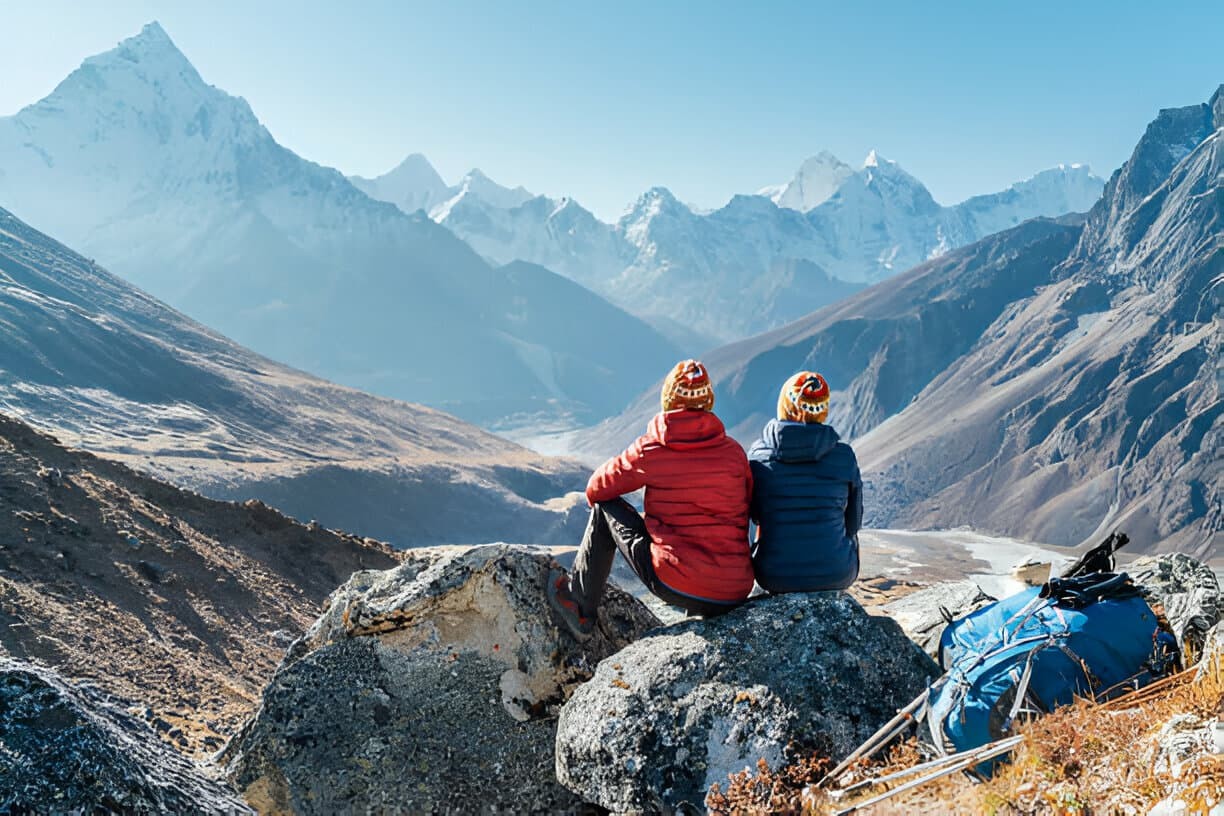
February marks a subtle transition as winter begins to loosen its grip on the region. Temperatures become slightly more manageable, ranging from -12°C to -3°C (10°F to 27°F). The trails remain quiet, offering a peaceful trekking experience without the crowds that characterize peak seasons.
While snow coverage starts to decrease, you'll still encounter icy patches, particularly in shaded areas and at higher elevations. The days get longer, providing more daylight hours for trekking. This month offers excellent visibility with clear sky that's perfect for mountain photography.
Trekking in February requires proper preparation, including high-quality hiking boots with excellent grip and spikes for icy trails. Wear multiple layers of clothing that can be adjusted throughout the day as temperatures change.
Starting early in the morning allows trekkers to make the most of the available sunlight and often provides the best weather conditions. Many teahouses remain open during this time, though some might operate with limited services, so it's wise to check availability in advance.
March - Beginning of Spring:
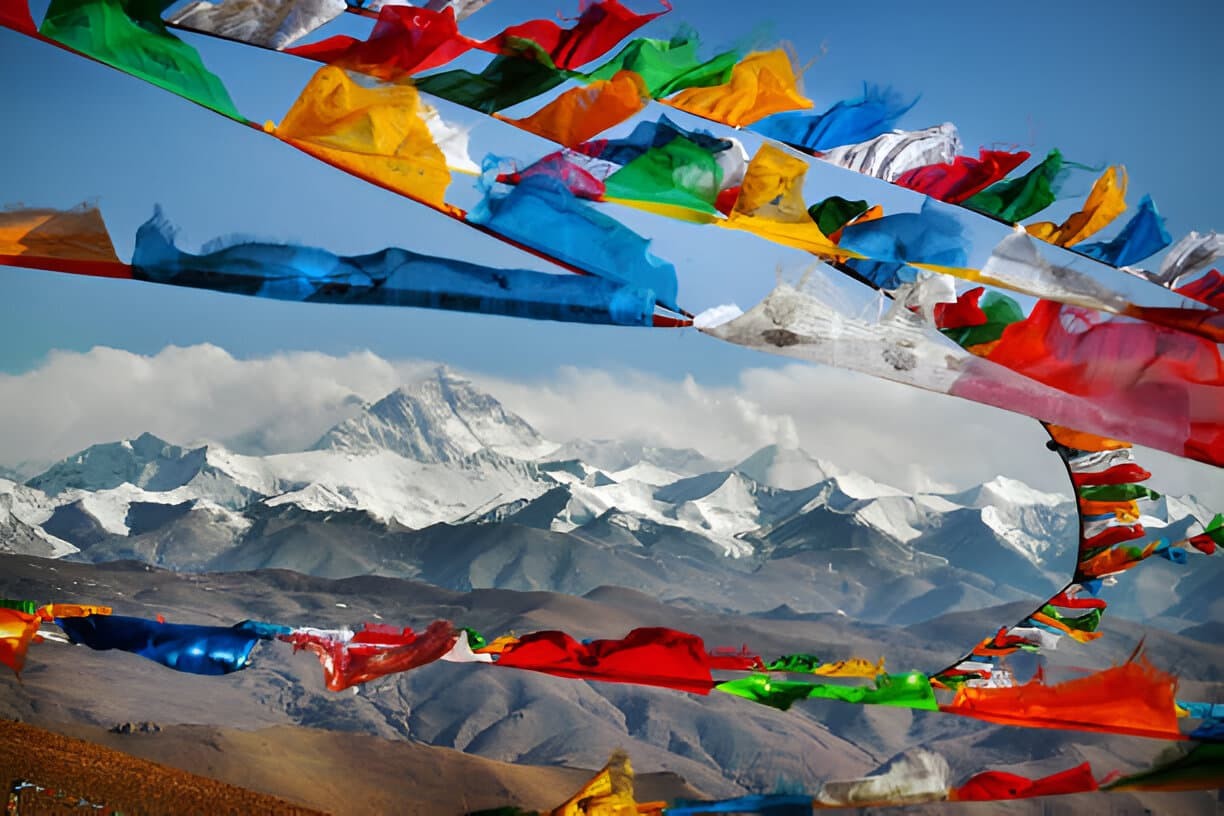
March marks the beginning of spring in the Everest Region, bringing significant changes to the trekking environment. Temperatures become more moderate, typically ranging from -10°C to 0°C (14°F to 32°F). This month marks the start of the first peak season, as trekkers begin arriving in larger numbers to take advantage of the improving weather conditions.
The snow from winter months mostly melts away, except at higher elevations, making the trails more accessible. However, March can be quite windy, particularly in the afternoons, as the changing seasons create weather fluctuations.
The landscape comes alive during this time, with the first signs of spring flowers appearing at lower elevations. The improving weather conditions mean more reliable flight schedules to Lukla, though morning fog can still cause occasional delays.
Proper preparation for March trekking should include both warm and lighter clothing options for layering, as temperatures can vary significantly throughout the day. Sun protection becomes increasingly important as UV radiation intensifies at higher altitudes. The teahouses begin their peak season operations, offering full services, though it's advisable to book accommodation in advance for popular stops.
April - Beginning of the Peak Season:
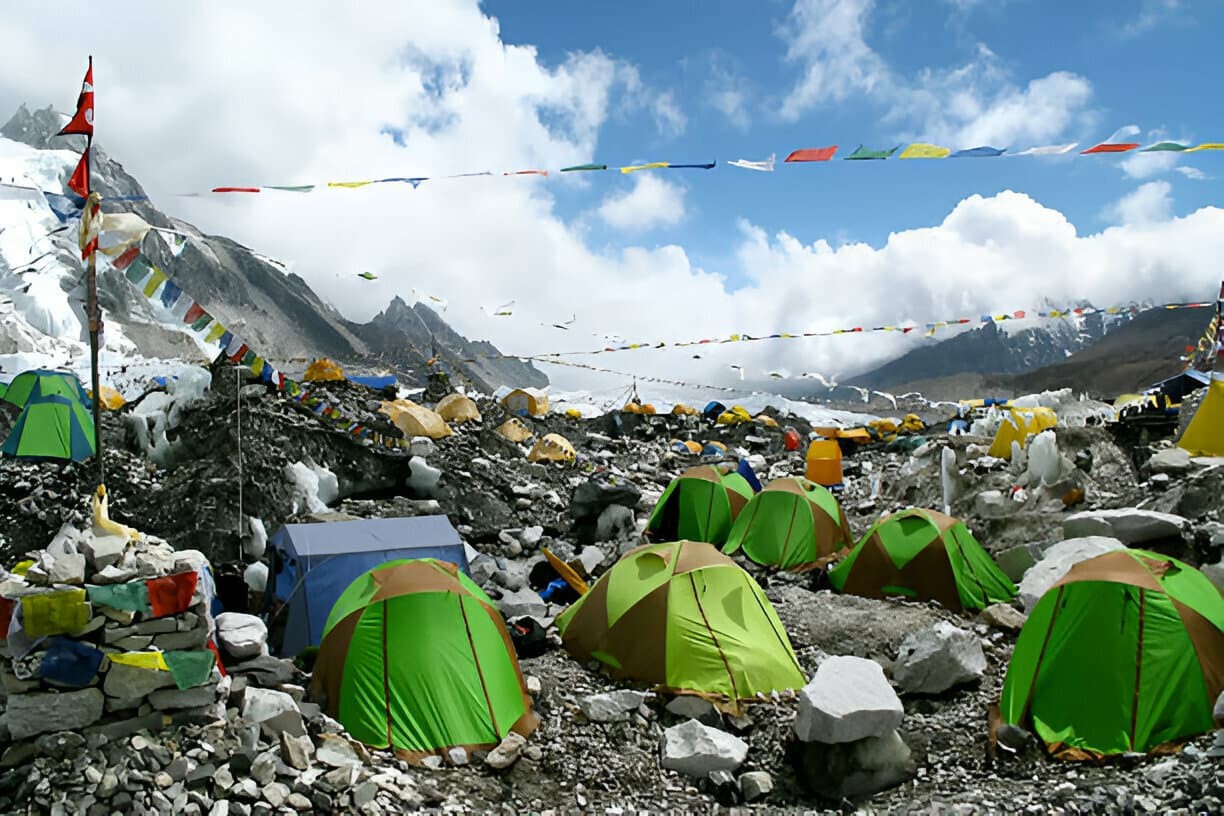
April stands as one of the most popular months for the Everest Base Camp trek, and for good reason. The weather turns notably pleasant, with temperatures ranging from -5°C to 10°C (23°F to 50°F). The skies remain predominantly clear, offering consistent views of the magnificent mountain ranges.
The rhododendrons bloom at lower elevations, painting the landscapes in vibrant colors and adding to the trek's visual appeal. However, this optimal weather brings significant crowds to the trail. All teahouses operate at full capacity, and popular spots like Namche Bazaar become quite busy. The trails can get dusty during this month due to increased foot traffic and the dry conditions.
To make the most of an April trek, it's important to book accommodations well in advance, particularly in popular stopping points. Begin your treks early, typically around 6 AM, to avoid the main crowd and enjoy more peaceful walking conditions. Carrying a dust mask or buff proves essential for comfort, especially on windy days. Despite the crowds, April offers some of the most stable and enjoyable trekking conditions of the year.
May - Heat Before the Monsoon:
May represents the final month of the pre-monsoon season, bringing warm temperatures ranging from 0°C to 15°C (32°F to 59°F). The first half of May still sees considerable traffic on the trails, though it begins to thin out as the month progresses and the early signs of monsoon appear.
The weather pattern becomes more unpredictable, with afternoon clouds frequently rolling in and occasionally blocking mountain views. However, mornings typically remain clear and offer excellent visibility. The warmer temperatures mean more comfortable trekking conditions, particularly at higher altitudes. The landscape reaches peak spring bloom, with various wildflowers dotting the lower valleys. Humidity levels start to rise, making physical exertion more challenging.
To handle May's conditions, trekkers should focus on early morning starts to capitalize on clear skies and cooler temperatures. Quick-dry clothing becomes essential as afternoon showers become more frequent. Though the chances of rain increase, May offers a unique opportunity to experience the region's transformation as it prepares for the monsoon season.
June - Monsoon Begins:
June marks the beginning of the monsoon season, bringing significant changes to the trekking experience. Temperatures become warmer, ranging from 5°C to 17°C (41°F to 63°F), but the increased humidity makes it feel warmer.
The rain usually starts as occasional afternoon showers early in the month, gradually increasing in frequency and intensity. The trails become considerably quieter as most trekkers avoid the monsoon season. While this means more peaceful trekking and easier accommodation availability, it also brings unique challenges.
The paths often become muddy and slippery, particularly at lower elevations. Leeches emerge in the forested areas below 3,000 meters, requiring extra precautions. Cloud cover frequently obscures mountain views, though occasional breaks in the weather can offer spectacular views.
For June trekking, waterproof gear becomes absolutely essential - from boots to rain jackets and pack covers. Carrying leech socks or salt for the lower portions of the trek helps manage the leech situation. The reduced visibility means trekking with an experienced guide becomes even more important for safety. Despite these challenges, June offers a unique perspective of the region, with lush vegetation and flowing waterfalls adding to the scenery.
July - Peak Monsoon Season:
July represents the peak of the monsoon season in the Everest region, bringing constant rainfall and persistent cloud cover. Temperatures remain warm, ranging from 7°C to 18°C (45°F to 64°F), but the high humidity makes trekking more strenuous.
The trail sees very few visitors during this time, and many teahouses operate with reduced services or may temporarily close. Flight schedules to Lukla become highly unpredictable, with frequent cancellations and delays due to poor visibility.
The terrain presents significant challenges, with very wet and muddy conditions throughout the route. Streams and rivers swell with monsoon rains, sometimes requiring careful assessment before crossing. However, July offers a unique perspective of the region's ecosystem, with the landscape at its most vibrant and green. Waterfalls reach their full power, creating spectacular displays throughout the lower valleys.
For those considering a July trek, extensive preparation is crucial. Waterproof equipment becomes your most valuable asset - from high-quality rain gear to waterproof bags for protecting electronic equipment and important documents. Planning extra days for potential flight delays is essential, and carrying additional food supplies is advisable. Despite these challenges, the solitude and raw natural beauty of the monsoon season provide an unforgettable trekking experience.
August – Monsoon Continues:
August continues the monsoon pattern with consistent rainfall and high humidity levels. Temperatures maintain their warm range of 6°C to 18°C (43°F to 64°F), but the constant moisture in the air makes it feel warmer. This month typically sees the lowest number of trekkers on the trail, offering an extremely quiet and solitary experience.
The biggest challenges during August include limited visibility of mountain peaks, increased risk of landslides in certain areas, and difficult trail conditions. The paths remain wet and slippery, requiring careful navigation. However, the region showcases its most lush and vibrant vegetation during this time. The valleys fill with a variety of flowering plants, and the agricultural fields in the lower regions display beautiful shades of green.
Trekking in August requires thorough preparation, an experienced guide who knows the terrain well. Daily weather monitoring becomes decisive for safety, particularly regarding landslide risks. Alternative routes might need to be considered if certain trail sections become unsafe. Despite these challenges, August offers a rare opportunity to experience the Everest region in its most natural and untouched state, free from the influence of tourism.
September - Post-Monsoon Transition:
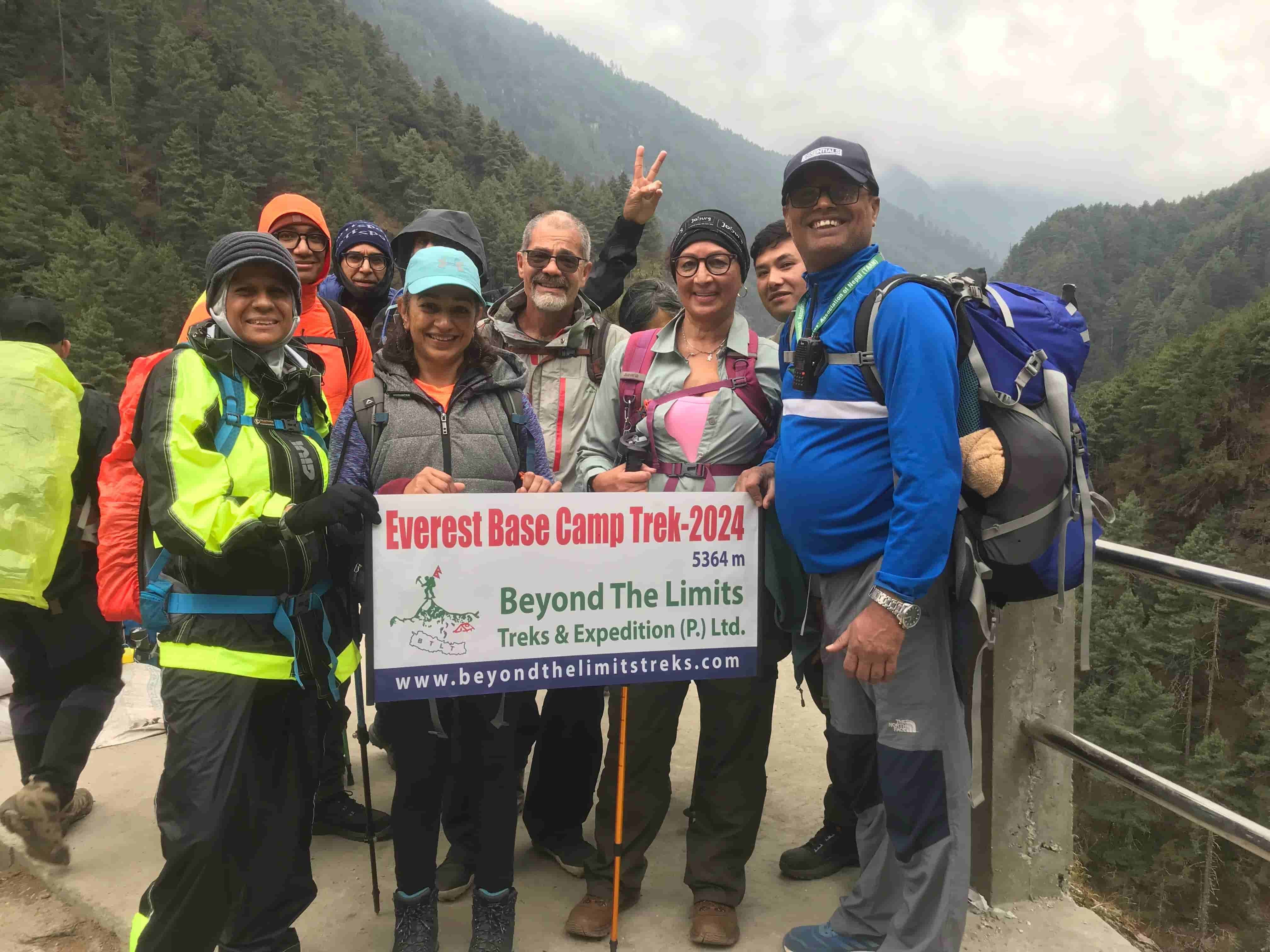
September marks a significant transition as the monsoon season begins to retreat. The month starts with lingering rain showers, but conditions gradually improve as week’s progress. Temperatures become more moderate, ranging from 4°C to 15°C (39°F to 59°F), and humidity levels start to decrease.
The landscape remains incredibly green from the monsoon rains, but the skies begin to clear, offering better mountain views. The number of trekkers starts to rise as the month progresses, but still the trails remain relatively quiet compared to the peak season.
The improving weather brings more reliable flight schedules to Lukla, however, morning fog can still cause occasional delays. Trail conditions also begin to improve, but you can encounter muddy sections, particularly in shaded areas. This month offers a unique combination of post-monsoon beauty and increasing visibility of the mountain ranges.
Trekking poles prove valuable during this time, helping with stability on the still-damp trails. The teahouses begin preparing for the upcoming peak season, resuming full services.
September trekkers often enjoy the best of both worlds - the lush aftermath of the monsoon and the beginning of clear mountain views.

October - Peak Trekking Season:
October stands as one of the most celebrated months for the Everest Base Camp trek, characterized by stable weather and excellent visibility. Temperatures become cooler, ranging from 0°C to 12°C (32°F to 54°F), creating comfortable conditions for long days of walking.
The skies remain consistently clear, offering unobstructed views of the Himalayan peaks throughout the day. This perfect combination of conditions attracts large numbers of trekkers, making it one of the busiest months on the trail. The atmosphere becomes festive, with trails and teahouses full of excited trekkers from around the world.
The landscape begins its transition to autumn colors, creating spectacular photo opportunities. However, the popularity of October trekking means that accommodation can be challenging to secure, particularly in popular stops like Namche Bazaar and Gorak Shep. Advance booking becomes essential, and flexibility with accommodation options helps.
Despite the crowds, October offers arguably the most reliable and enjoyable trekking conditions of the year. The clear weather also means more consistent flight schedules to and from Lukla, helping trekkers stick to their planned itineraries.
November – Crisp autumn, with Cooler temperature:
November continues the ideal trekking conditions with clear, stable weather, though temperatures drop notably as winter approaches. Daily temperatures typically range from -5°C to 8°C (23°F to 46°F), with considerably colder nights. The first half of November remains busy with trekkers, but crowds begin to thin out as the month progresses and temperatures decrease.
The air becomes increasingly crisp and dry, offering exceptional visibility and mountain views. The reduced moisture in the air creates perfect conditions for photography, with the mountain peaks standing out sharply against the blue skies.
Trekking in November requires increased attention to cold-weather preparation, particularly for the nights and early mornings. Teahouses remain fully operational, though some begin to scale back their services toward the end of the month.
The clearer weather patterns generally mean reliable flight schedules, though occasional morning fog at Lukla can cause delays. The combination of stable weather, quieter trails (especially late in the month), and stunning visibility makes November an excellent choice for those who can handle colder conditions.
December - Winter Chill Returns:
December brings full winter conditions to the Everest region, with temperatures dropping significantly to range between -12°C to 0°C (10°F to 32°F). The air becomes very dry and cold, but the skies often remain clear, offering spectacular mountain views when weather permits.
The trails become notably quiet, with only the most dedicated trekkers taking on the winter challenge. Snow begins to accumulate, particularly at higher altitudes, creating both beautiful landscapes and challenging trekking conditions. The reduced daylight hours require careful planning of daily trekking schedules.
Many teahouses operate with limited services, and some may close entirely, making advance checking of accommodation essential. However, December trekking offers unique rewards: the perfect winter landscapes, absolute silence on the trails, and a more authentic experience of local life in the mountains.
Proper winter gear becomes crucial - quality down jackets, thermal layers, and sleeping bags rated for extreme cold are essential. Starting days early to maximize available daylight helps maintain a safe trekking schedule. While December presents significant challenges, it offers an unparalleled opportunity to experience the raw, winter beauty of the Everest region without the crowds that characterize other seasons.
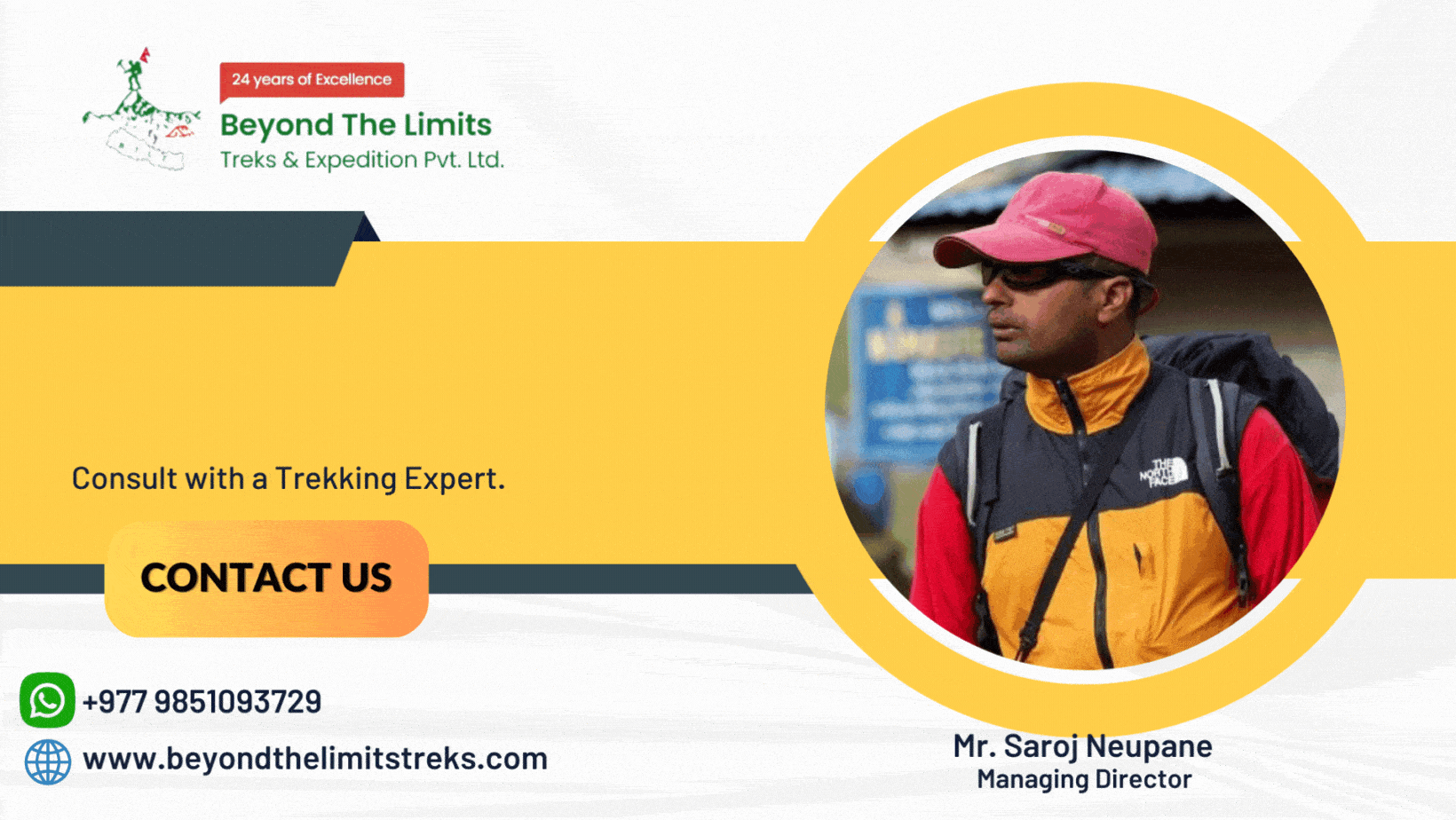
Conclusion
Trekking to Everest Base Camp is an amazing adventure, but choosing the right time to go will shape your experience. Every month has something special to offer, along with its own challenges. Whether you want clear skies, peaceful trails, or wild weather, there’s a season for you.
Best Overall Months:
The best time for most people is April and October. These months have sunny days, cool weather, and great mountain views. The trails are busy, but you’ll meet many fellow trekkers and enjoy lively teahouses. If you prefer quieter trails but still want good weather, try March or November. March brings blooming flowers, while November has crisp, clear skies and fewer crowds.
For Adventurous Spirits
If you love snow and quiet, try December to February. These winter months are freezing, but the trails are empty, and the mountains look magical under snow. You’ll need warm clothes and patience for flight delays. For a totally different vibe, June to August (monsoon season) offer green valleys, flowing waterfalls, and empty trails. But be ready for rain, muddy paths, and leeches! These months test your toughness but reward you with a unique, wild side of the Himalayas.
Key Considerations:
No matter when you go, remember these tips:
- Prepare well: Pack clothes for cold, heat, or rain. Take time to get used to the high altitude.
- Stay flexible: Flights to Lukla often get delayed, and weather can change fast. Add extra days to your plan.
- Respect the mountains: Pick a season that matches your fitness and comfort level. Crowded trails in peak season might feel exciting, but quiet winter hikes need extra preparation.
There’s no “bad” time to trek, just what works best for you. Whether you want perfect photos, peaceful walks, or a rainy adventure, Everest Base Camp will leave you speechless. Plan smart, take it slow, and enjoy every step. The mountains are calling!
More Blogs related to Everest Trekking:













